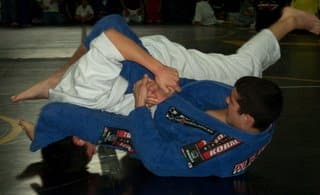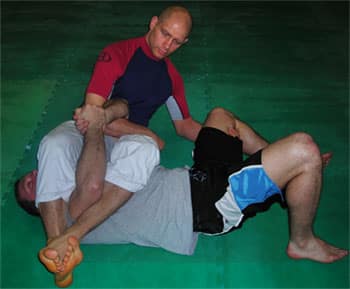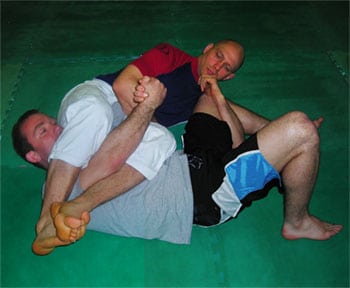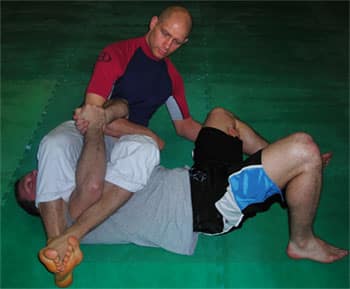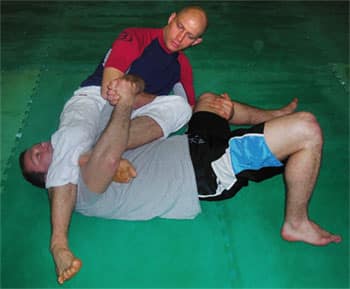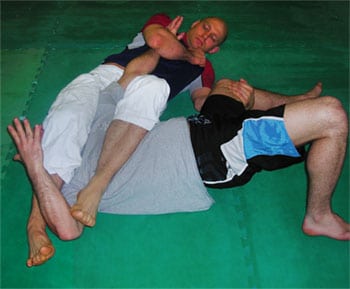The armbar, as it is usually taught, involves using BOTH of your hands or arms to control ONE of your opponent’s arms.
This two-on-one control can be used when trying to break through your opponent’s defenses, as in the photo below:
The two-on-one arm control is usually retained right until your opponent taps out to the finalized armbar, as in the following photo:
Now this regular ‘two-on-one’ armbar control has won a LOT of matches in BJJ, MMA, submission grappling, judo, sambo, etc. It is a tried and true approach, but unfortunately that also means that there are a LOT of counters to this type of armbar.
Prior to a few years ago, I’d seen some one-handed armbar variations where the top arm controlled the arm and the bottom hand controlled the near leg. I thought that these were simply interesting variations, and not really bread-and-butter material.
Then my my longtime training partner, Vlado Skrepnik, started attacking me with the one-handed armbar. I remember feeling really frustrated, because his control of my leg effectively killed most of my escape techniques.
Most armbar counters rely on turning into your opponent, or turning away from your opponent and/or getting to your knees – all of which are nullified by his control of your leg. For example, completing this simple armbar escape, becomes virtually impossible until you free your leg from his grip, because you just can’t get your legs underneath you in base while he is holding your near knee.
About a year after after Vlado started using this style of armbar I came across a book by Eddie Bravo, and discovered that Eddie calls this position the “spider web” and uses it as the foundation of his armbar attacks. Maybe these guys were onto something, I thought, and decided to find out for myself.
Since that point I have experimented with this style of armbar, and generally I’ve been pretty happy with it. It really does make it much more difficult for your opponent to escape the armbar position. Furthermore if you don’t give up much control or power over his arm IF you use correct technique.
Below I’ll take you through a two variations of the initial position, and then show you a simple way to break your opponent’s grip when he locks his hands together to counter your arm bar.
One-armed armbar, shallow grip
I am sitting up and leaning slightly towards his legs. Note how my bottom hand controls his leg by gripping behind the knee (with the gi you can grip cloth). My top arm is inserted DEEP on his arm (inner elbow to inner elbow) – in this case I am cupping my own thigh to keep things tight.Note that I prefer crossing my feet in this armbar position, and having my bottom foot over my top foot feels the most natural to me.
One-armed armbar, deep grip
This variation is pretty similar except that I am lying down on my left side and my left arm is hooked much more deeply around his leg.
One-armed armbar counter and recounter
Here I am in the one-armed armbar position, but my opponent is blocking my armbar by clasping his hands together and preparing his escape. I have many options to counter his counter (what I call ‘re-counters’), but here is a simple, high-percentage option:
Maintaining my grips in exactly the same position I place the foot of my bottom leg on his far bicep. I push with my leg and pull with my lower back creating a tremendous pressure on his grip. If he needs more convincing to let go I ‘jackhammer’ my leg in a series of short, sharp stomps.
My opponent has released his grip, and I keep my foot on his bicep while falling back. The crook of my elbow starts sliding up his forearm towards his wrist, increasing the length of my lever and the amount of force I can generate on his arm.
I’ve now fallen all the way back, still maintaining my grip on his leg. Note how the crook of my arm is now at his wrist, which is much more secure than grabbing his wrist with my hand. He taps out!
Try it for yourself and I’m sure you’ll see the power of using one of your arms to control your opponent’s near leg rather than tying up both of your arms on your opponent’s one arm.
You may not end up making this your bread and butter attack, but it’s a very useful tool to have in your toolbox, especially if your opponent is really determined to come to his knees when caught in an armbar.
Also – above we covered one very simple armbar defense recounter (kicking the arms apart using your lower leg). It’s simple, powerful, but it doesn’t work on everybody.
In the two videos below I cover 20 more high-percentage ways to break that darn grip. You don’t need to learn them all, but you should probably become passingly familiar with them in case someone tries to use one of them on you!
The post A Better Armbar? appeared first on Grapplearts.

